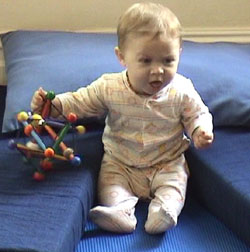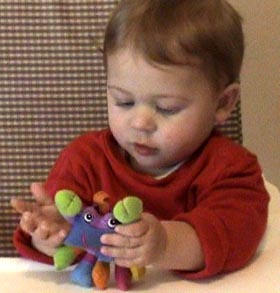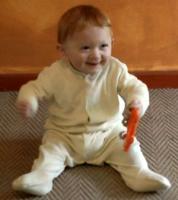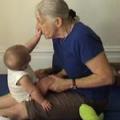Babies use their hands to explore, learn about and interact with the social and physical world they live in.
Typically developing babies learn easily in the course of their daily lives. Infants with movement difficulties may need some help and dedicated practice time to ensure that they learn to use both hands effectively.
Babies with developmental delay often do not learn in the same easy way and early recognition of hand (fine motor) difficulties is important so that parents can provide their babies with the extra help they may need to learn to use their hands well.
|
Babies at risk for developmental delay of hand function Preterm babies, babies who experienced a difficult birth, Downs syndrome, cerebral palsy, babies at risk for autism, infant stroke (hemiplegia) |
In this article I describe all the different ways babies use their hands and provide pointers to identifying your baby's abilities as well as the movement tasks for which they that they may need extra practice to master. If you feel that your baby's hand (fine motor) development is lagging behind, and especially if one hand seems to be weak it is important to get a referral for an occupational or physical therapy assessment. Doctors often have a wait-and-see policy, but this is a really bad idea because rich and varied early experience of using the hands to explore and interact with the environment is important for more complex hand function as well as language and cognitive development.
Read more: How infants use their hands to grow their brains
Taking time to observe your baby's hand actions
You can observe your baby's hand actions when they are sitting in a reclining seat, bouncy chair , a feeding chair or sitting on the floor with some support if needed.
The important thing is that your baby's trunk should be well supported so that the arms can be moved without disturbing the baby's balance.

If your baby is sitting independently, but the balance is not quite secure, it helps to put a 10 cm high foam block or firm sofa cushion either side of the hips.

Sit opposite your baby so that you can communicate with each other and you can observe their actions.

Rubbing, scratching, patting and grabbing
Babies often rub their hands across, or scratch new and interesting surfaces, their clothing and own bodies. These actions provide your baby with information about the texture and softness or hardness, of surfaces and materials around them.
These repeated movements of the hands and fingers are also important for improving your baby's control of their hand and finger movements.

Observe your baby's exploratory behaviors
Watch your baby's hand movement when they are lying or sitting with support, without there being any toys within easy reach.
Do they move their hands over the surrounding surfaces, grab at clothing, or touch their body?
Do they explore one hand or foot with the other?
Do they move one hand more than the other?
Does changing the texture of the support surface increase their exploration?
What do they do if you tie a ribbon with a bell on their one wrist or ankle?
Reach for, grasp and hold


Observe your baby
Place or hold two or three easy to grasp toys within easy reaching distance and in front of the baby’s chest.
Notice how they move one or both hands to reach for or pick the toy up.
Do they open their fingers in readiness for grasping the toy?
Do they use two hands if the toy is big?
Do they take time to inspect the toy?
Do they bring the toy to their mouth?
Do they pay close visual attention to their hands and the toy?
Soft easy to grasp toys that have tags, legs and ears to explore
Grasp, hold, shake or bang
By 6-8 months babies have learned to keep hold of a toy they have grasped. Shaking toys vigorously is a favorite action. The shaking action teaches the infant to grip the toy firmly to counteract the momentum force produced by shaking the toy.
Infants also love to repeatedly bang toys on a hard surface.


Observe your baby
Have a small selection of toys that are easy to grasp and make a noise when they are shaken.
Make different rattles using plastic bottles or jars with a small amount of rice or hard object inside. These can also be banged to make an interesting noise.
Pick up and shake one of the rattles and maybe talk about the noise it makes. Then give your infant time to look at the rattles and decide what they want to do next. Often the first action is to bring a toy to the mouth.
Does your infant pick up and shake or bang a rattle?
Does she try moving it in different ways to explore the different noises it make when moved faster or slower, or in different directions?
Grasp, hold and move with two hands
At this age babies are also learning to hold larger toys and objects with two hands. To do this the two arms need to work together. For instance, when picking up a bottle or tin the two hands one needs to apply the same amount of pressure on the bottle or the tin to hold it steady.
Babies with weakness in one arm will have difficulty lifting up a toy with two hands.

Observing your baby
Place a two or three toys that need to be picked up with two hands within easy reaching distance and in front of your baby. Remember to give your baby time to look at the toys. This looking time allows the perceptual-motor brain to figure out what is the best option for this particular task.
Some ideas for homemade toys that are good for two-handed pick up: jars, plastic bottles, cardboard boxes.
- Do they reach for the toy with both hands? Can they hold the toy with both hands?
- Can your baby pick up a biggish ball with two hands?
Grasp, hold and explore with the other hand
When given a toy that has moveable parts, babies will hold the toy with one hand and use the fingers of the other hand to feel and move the different parts of the toy.

Observe your baby
Place a few toys that have moveable bits in easy reach for your baby to pick up and explore.
- Does your baby take time to inspect the toy from different angles and move it in different ways?
- Does you baby hold the toy with one hand and use the other hand to pull on, flip or rotate the moveable bits?
Plastic toys with moveable parts
Manipulating toys using two hands
At this age babies will frequently pass a toy from one hand to the other.


They also like to turn the toy over to inspect the other side


Observe you baby
Put 2-3 flattish toys in easy reach for your baby to pick up.
- Your baby may spend time visually inspecting, mouthing and feeling the toy.
- Watch carefully to see if your baby also passes the toy from one hand to the other and turns it over.
Hand gestures
This is the age that babies start to use their hands for communication, especially when they live with people who use their hands a lot when talking.
Look out for holding the hand out and open or opening and closing the fingers when they see something they want.
Infants are starting to point towards objects, often just stretching the arm forwards and later on pointing with one finger.
What next?
If you are concerned about your baby's hand development, then it is a good idea to ask for a referral to specialist pediatric physical or occupational therapist. for a full assessment.
This particularly important if you notice that your baby is not using one hand as much as the other, or one hand seems to be weaker.
A wait-and-see approach is not a good idea because this is a time of very rapid brain development, which depends on experience. Less experience - fewer brain connections.
In the meantime, or if you are not able to see a physical therapist
You may want to start providing your infant with opportunities practicing hand tasks. This is not difficult, it just takes a bit of time and knowhow.
| Activities for training baby hands from 7-12 months |
Selected bibliography
For a full bibliography on infant hand use please see here
Koterba, E. A., Leezenbaum, N. B., & Iverson, J. M. (2012). Object exploration at 6 and 9 months in infants with and without risk for autism. Autism : the international journal of research and practice, 18(2), 97-105.
Lobo, M. A., Galloway, J. C., & Heathcock, J. C. (2014). Characterization and intervention for upper extremity exploration & reaching behaviors in infancy. Journal of hand therapy : official journal of the American Society of Hand Therapists, 28(2), 114-24; quiz 125.
Lobo, M. A., Kokkoni, E., Cunha, A. B., & Galloway, J. C. (2014). Infants born preterm demonstrate impaired object exploration behaviors throughout infancy and toddlerhood. Physical therapy, 95(1), 51-64.
